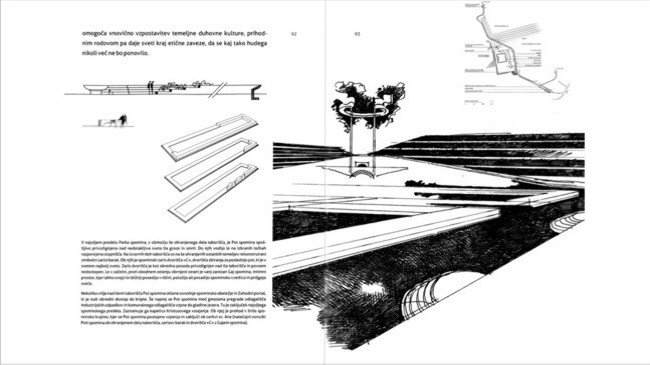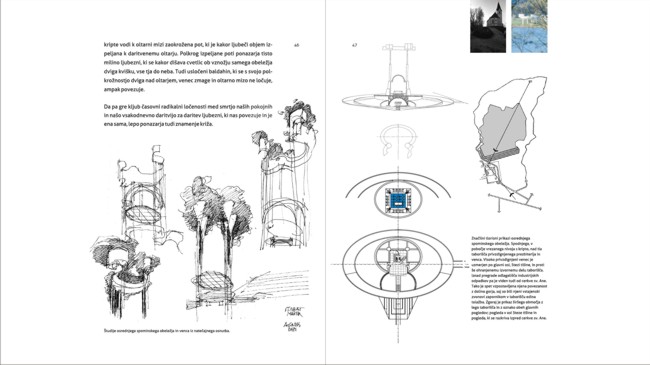



|
Iz knjige ...Odkar človek hodi pokonci, zre v nebo, dviga roke k zvezdam, da bi jih nabral v šopek ali da bi objel sonce, luno, razmišlja, kaj vse je za njim in kje so njegovi dragi, od katerih se je sicer poslovil, nikoli pa ni sprejel, da jih enostavno ni več in da jih nikoli več ne bo videl. Poprej jih je že zagrebel v zemljo, kraj pokril z listjem in nanj položil kamen, da bi vedel, kje je njihova poslednja postaja, od koder so odšli tja, kjer sam še nikoli ni bil, kamor upa, da enkrat pride tudi sam in jih znova sreča. Te pomenljive kretnje smemo imenovati začetke civilizacije, saj antropolog Claude Lévi-Strauss pravi, da je človek postal človek, ko je začel pokopavati svoje drage... ...Osnovna želja arhitekta Marka Mušiča je bila ustvariti sveti prostor Spomina. Spomin ni samo začetek človeške inteligence, saj brez njega misel ne more delovati, ampak tudi temelj naših najglobljih občutij in verovanj... Iz poglavja Osrednje spominsko obeležje ...Mušičevo osrednje spominsko obeležje spada med najbolj monumentalne slovenske spomenike. V Spominskem parku Teharje pomeni ta sakralni objekt največji kontrast, ki ga lahko omogoči arhitekturna zasnova... V arhitektovi zamisli osrednjega spominskega obeležja prepoznamo tudi trojno doživljanje absolutnega časa. Najprej je tukaj kripta, ki ponazarja absolutno preteklost. Bolečine, trpljenja in smrti naših dragih enostavno ni mogoče izbrisati, ni jih mogoce priklicati v naše življenje. Toda nad njo se dviga oltar absolutne sedanjosti. To so naš spomin, naša molitev in sveta daritev, preko katere segamo v večnost, v večni sedaj, kjer so, vsaj tako upamo, tudi naši pokojni. Slednjič je na vrhu tudi venec zmage kot simbol absolutne prihodnosti. To je tisti mesijanski čas, ki ga šele zaznavamo in kjer bo vse hudo pozabljeno. Ne bo več ne žalovanja ne vpitja. Tudi daritve ne bo vec. Kar bo ostalo, bo le Ljubezen. Ljubezen je tista pot, po kateri je mogoče prehajati iz enega časa v drugega... Iz poglavja Kostnica ...Arhitekt Mušič je že v začetku zasnove Spomiskega parka predvidel možnost kostnice... Kostnica je umeščena v obodnem delu kripte in v grobnici, ki je vkopana v njenem zaledju. Vsi vhodi v kostnico vodijo skozi kripto, simbolno in pietetno žarišče spodnjega nivoja osrednjega spominskega obeležja. Študija prikazuje možne lokacije kostnice v najožjem obmocju Parka spomina. Iz poglavja Vrt vrnjenih imen ...Vrt vrnjenih imen si je arhitekt zamislil kot prostor, ki bi bil zaznamovan z alejo kenotafov in z znamenjem križa. Arhitekt je park spoštovanja imen postavil nekako vzporedno s Stezo tišine, in sicer na zahodno stran Poti spomina. Gre za dokončno ureditev Spominskega parka, ki še čaka na svojo ureditev... From the book …Since man walks upright, staring at the sky, raising hands to the stars to collect them in a bouquet or to hug the sun, moon, thinking what was and where are the dear ones from whom they said goodbye, but never accepted that they simply no longer are and that they will never be seen again. Previously they had been snapped up in the earth; the place covered with leaves and laid the cornerstone to know where their last stop is, from where they went to where he had never been, where one hopes to reunite with them again. These meaningful gestures must designate the beginnings of civilization, as anthropologist Claude Lévi-Strauss says that man became man, when he began to bury their loved ones ... …Basic wish of architect Marko Mušič has been to create a sacred space of Memory. Memory isn't just the beginning of human intelligence, because without it thought can not act, but also the foundation of our deepest feelings and beliefs ... The chapter Central memorial ... Mušič's central memorial is one of the most monumental Slovenian memorials. In Memorial Park Teharje the ecclesiastical building represents the largest contrast architectural design can enable. In the architect's idea of a central memorial one can recognize the triple experience of absolute time. First of all, here is the crypt, which illustrates the absolute past. Pain, suffering and death of our precious simply can not be deleted; they can not be recalled to our lives. But above it the altar raises representing the absolute present. These are our memory, our prayer and sacrifice through which we reach to eternity, into the eternal presence where they are, at least so we hope, our deceased. Finally, at the top, the wreath of victory as a symbol of the absolute future. This is the messianic time that you just perceive and where everything severe will be forgotten. There will not be no more sorrow and cry. Even sacrifices will no longer be. What's left is just Love. Love is one way by which it is possible to pass from one time to another ... From chapter Ossuary …Architect Mušič foresaw the possibility of placing the ossuary in the Memorial park from the beginning of the project. Ossuary is sited in the peripheral part of the crypt in the tomb, which is dug into its hinterland. All entrances to the ossuary run through the crypt, symbolic central focus of the lower level of the memorial. The study shows possible location of the ossuary in the central part of memorial park. The chapter Garden of the returned names …Garden of the returned names was conceived by the architect as a space that would be marked by Alley of cenotaphs and the sign of the cross. The architect designed the park of respect parallel to the trail of silence, on the west side of the memory path. This is the final arrangement ob Memorial Park Teharje, which awaits its realization ... CIP -Kataložni zapis o publikaciji Narodna in univerzitetna knjižnica, Ljubljana 72 (497.4): 929Mušic M. KOVAČ, Edvard Park spomina Teharje : arhitekt Marko Mušič / [besedilo] Edvard Kovač; [risbe, nacrti in modeli Marko Mušič in Atelje Marko Mušič; fotografije Miran Kambič in arhiv Ateljeja Marko Mušič]. - Ljubljana: SAZU - Slovenska akademija znanosti in umetnosti: Atelje Marko Mušič, 2011. - (Vodniki k arhitekturi; knj. 4) ISBN 978-961-268-016-9 (SAZU) Park spomina Teharje razglašen za / Memorial Park Teharje declared (junij 2014 / June 2014) NATIONAL CULTURAL MONUMENT "...Vlada Republike Slovenije je na včerajšnji seji za kulturne spomenike državnega pomena, ki imajo izjemen pomen za Republiko Slovenijo, razglasila tri nove spomenike državnega pomena, med njimi tudi spominski park Teharje, poroča STA. Prostor nekdanjega taborišča Teharje, sedanji spominski park, je s simbolno arhitekturno krajinsko ureditvijo osrednji državni park in osrednji simbolni spomenik Republike Slovenije, ki je posvečen spominu na žrtve vseh povojnih pobojev, in tako predstavlja izjemen del zgodovinske dediščine Slovenije. Park je bil urejen po načrtih arhitekta Marka Mušica..." (Vir: STA / M. M. Š.) The government of the Republic of Slovenia has at its yesterday’s meeting proclaimed cultural monuments having an exceptional meaning for the Republic of Slovenia, between them also the Memorial park in Teharje, reports STA (the Slovenian Press Agency). The area of a former concentration camp, the actual Memorial park, represents with its symbolic architectural and landscape design the central Memorial Park and the central symbolic monument of the Republic of Slovenia dedicated to the memory of victims of all after war manslaughters. Thus it represents an outstanding part of the Slovenian cultural heritage. The Memorial park in Teharje was arranged according to the plans (projects) of architect Marko Mušič. [ < ] |